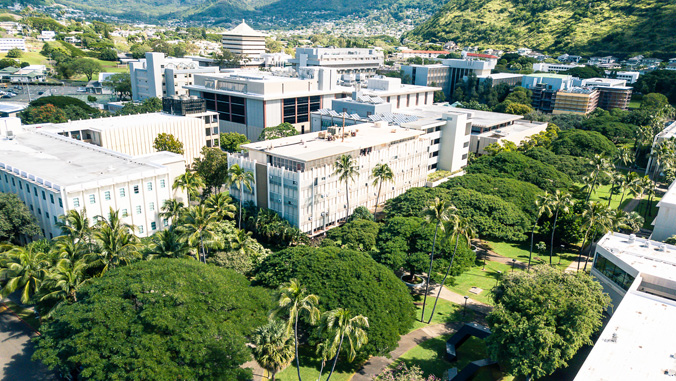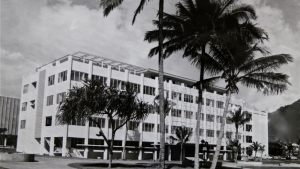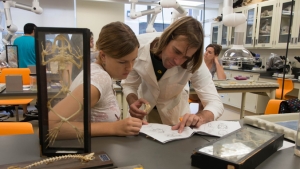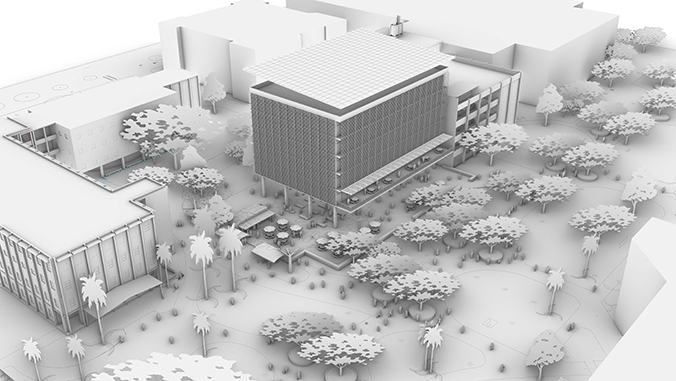
University of Hawaiʻi at Mānoa’s Snyder Hall, scheduled for demolition in June, will be remembered for its world-class research, and for many, being part of bygone era when laboratory animal science was a common practice at universities around the country. As researchers made groundbreaking discoveries, former students and employees from the 1970s and 1980s recall the eerie animal noises echoing through McCarthy Mall, where Snyder Hall is located.
The five-story concrete building was built in 1962 for $1.5 million. Snyder Hall was replaced in 2020 with the $65-million state-of-the-art Life Sciences Building located on the East-West Road end of McCarthy Mall.
Snyder Hall part of largest campus expansion

Snyder Hall was among 37 new buildings constructed during the biggest campus expansion ever at UH Mānoa during the mid 1950s to mid 1960s. Initially spearheaded by then UH President Paul Bachman, the buildup was supported by a new generation of Democratic lawmakers, who had just ended a half century of Republican legislative control. Many of the lawmakers who overrode a governor’s veto to fund the expansion with tax increases were UH graduates and World War II veterans.
Bachman died unexpectedly in 1957, and was replaced by Laurence H. Snyder, an internationally known geneticist. During Snyder’s tenure as president from 1958 to 1963, UH doubled the number of students, academic courses, and degree programs offered. He also oversaw the construction of the new buildings and the installation of the iconic pedestrian thoroughfare, McCarthy Mall, one of Snyder’s proudest accomplishments.
One of the new buildings, the Health Research Institute Building, was renamed Snyder Hall in 1967 in his honor.
World-class research 
Snyder Hall was home to a number of internationally recognized academics performing cutting-edge research in biology and microbiology.
Here are just a few examples of the world-class research performed there over nearly six decades.
- Microbiology Professor Maqsudul Alam led a group that sequenced the genome of SunUp papaya, the first published tropical fruit genome sequenced. Alam also discovered haem-containing proteins in the Archaea and Bacteria, proteins which trigger responses to oxygen, for which he was awarded a UH Excellence in Research Award (2001). He also established the Advanced Studies in Genomics, Proteomics and Bioinformatics facility, now based in the new Life Sciences Building.
- Microbiology Professor Phil Loh is credited with the invention of the field of shrimp tissue cell culture, which has allowed the study of viruses that infect shrimps. Loh also founded the virology program in 1961 and was the first person at UH to receive the Regents’ Medal for Excellence in Research in 1965.
- Microbiology Professor Clair Edwin Folsome was world renowned for his studies on the origins of life, astrobiology and closed biosystems.
- Microbiology Professor Stuart Donachie’s lab discovered still the second only known species in a unique cyanobacteria order with the first having been discovered in 1974. The sample came from a cave in the Kīlauea Caldera, and provides an “edit” to the history of the evolution of photosynthesis. Donachie’s lab has cultivated and named many other new microbes from Hawaiʻi.
- Microbiology Professor Tung Hoang‘s lab studies bacterial infectious diseases and developed a pioneering method for studying functional genomics of single bacterial cells based around a system called “laser micro-dissection,” funded by the National Science Foundation in 2008 and grants from the National Institute of Health. The laser system is housed in the Biological Electron Microscope Facility, which has its own impressive history.
Thousands of researchers supported by Biological Electron Microscope Facility
The Biological Electron Microscope Facility (BEMF) was established at Snyder Hall in 1984 by UH Pacific Biosciences Research Center Emeritus Professor Richard D. Allen. Allen was world renowned for his work on the model organism Paramecium. Over the years, BEMF has been utilized by more than a thousand researchers from UH, local technology companies, state and federal agencies and other academic institutions. BEMF’s state-of-the-art equipment is used to examine biological samples from viruses, bacteria and other microbes, invertebrates, vertebrates, plants and materials science samples such as photovoltaic thin films and fuel cell membranes.
The facility’s mission to provide instrumentation, training and services to the broader scientific community continues today in its new home in the Life Sciences Building.
Frogs and monkeys and sea lions, oh my!
The Laboratory Animal Service (LAS) was located on the 5th floor of Snyder Hall, which included an outdoor patio area. The early 2000s witnessed a major reduction in live-animal research due to increasing activism and rising costs, with the last animals leaving the building in 2007.
A wide array of animals were housed there, including mice, rats, rabbits, guinea pigs, chickens, cats, Xenopus frogs, owls and Rhesus monkeys. The Rhesus monkeys are apparently what made the most and loudest noises, which echoed through McCarthy Mall.
“The old-timers told me of some brazen escapes in the 1980’s,” said retired UH Mānoa LAS employee Norman Magno. “Individual Rhesus escaped the pens and climbed down the adjoining coconut trees, entered Webster Hall quietly, and attended psychology and nursing classes with students without them knowing that a monkey was in attendance. I have been told stories like this on several occasions.”
Magno also said the “old-timers claim that sometime in the 1970’s and before the establishment of the animal advisory committee (now referred to as the Institutional Animal Care and Use Committee), sea lions were housed in inflatable swimming pools on the 5th floor Snyder Hall Patio. Passersby often reported hearing dogs barking in the morning hours, that were actually the sea lions.”
Snyder demolition part of larger campus plan
The demolition of Snyder Hall will be the latest completed project in the UH Mānoa’s Long Range Development Plan, following the demolition of Henke Hall in 2017, and construction of the now open Life Sciences Buildings in its place. The 2021 state Legislature approved funding for a new building on the Snyder Hall site that will have flexible learning and office spaces to support modern methods of online course delivery, collaboration and advising.
The plan identified Snyder Hall as the first of four buildings to be renovated, replaced or removed because of age and condition, and to reduce energy and maintenance costs. The other buildings are Holmes Hall, Keller Hall, and Kuykendall Hall.
Another project, the $41-million renovation of the Sinclair Library into a Student Success Center, is currently underway. The plan also calls for replacing campus interior roads with pedestrian malls, and removing more than 50 portable buildings on campus to create more open space.
This capital improvement effort is an example of UH Mānoa’s goal of Enhancing Student Success (PDF), one of four goals identified in the 2015–25 Strategic Plan (PDF), updated in December 2020.



